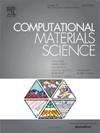A novel phase of germagraphene — Quasi-direct bandgap and anisotropic carrier mobility with potential optoelectronic response
IF 3.1
3区 材料科学
Q2 MATERIALS SCIENCE, MULTIDISCIPLINARY
引用次数: 0
Abstract
The experimental feasibility of implanting germanium into single-layer graphene (ACS Nano 12 2018 4641) motivates us to propose a new phase of monolayer rectangular germa-graphene (R-GeC) using first-principles calculations. In this article, we predict and critically explore a novel formation of germa-graphene monolayer with all its structural intricacies, underlying electronic nature, carrier mobility and relaxation time scales added with the subsequent optical response. This novel monolayer exhibits a semiconducting electronic nature with a quasi-direct bandgap of 0.40 eV at a non-high-symmetry location in the Brillouin zone. Lower deformation potential values indicate relatively weaker electron–phonon scattering, facilitating ultrahigh carrier mobility and picosecond order relaxation times. Tiny and anisotropic carrier effective masses suggest rapid carrier transport properties and increase the efficiency of photogenerated electron–hole separation. The optical signatures of this proposed rectangular germa-graphene have been compared with the well-established form of rhombohedral GeC. The real part of the dielectric function indicates the presence of plasma frequency in the parallel polarization direction, signifying a transition from metallic to dielectric behavior. Both the proposed R-GeC and its rhombohedral variants are observed to absorb excitations all over the visible, infrared and near-infrared regimes with detectable birefringence. Such exotic features are key indicative of this R-GeC being one of the better choices for transport and optoelectronic sectors.

求助全文
约1分钟内获得全文
求助全文
来源期刊

Computational Materials Science
工程技术-材料科学:综合
CiteScore
6.50
自引率
6.10%
发文量
665
审稿时长
26 days
期刊介绍:
The goal of Computational Materials Science is to report on results that provide new or unique insights into, or significantly expand our understanding of, the properties of materials or phenomena associated with their design, synthesis, processing, characterization, and utilization. To be relevant to the journal, the results should be applied or applicable to specific material systems that are discussed within the submission.
 求助内容:
求助内容: 应助结果提醒方式:
应助结果提醒方式:


